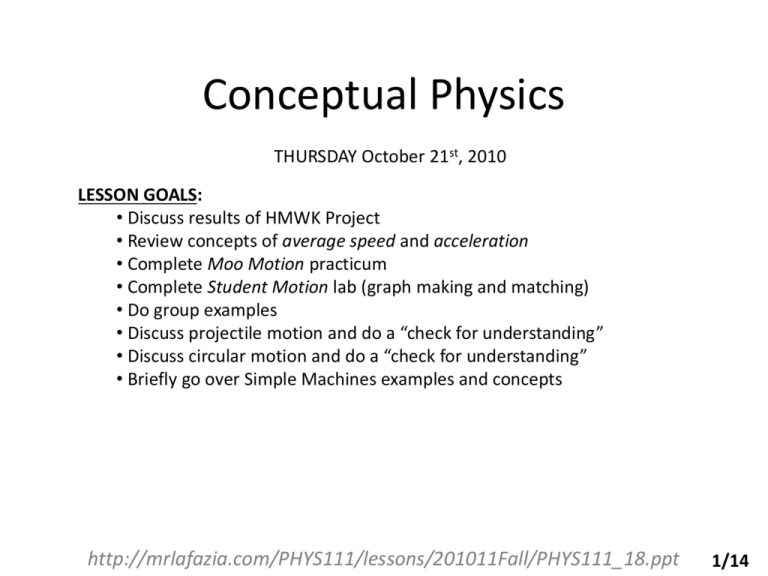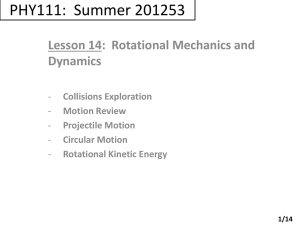PHYS111_18 - MrLaFazia.com
advertisement

Conceptual Physics THURSDAY October 21st, 2010 LESSON GOALS: • Discuss results of HMWK Project • Review concepts of average speed and acceleration • Complete Moo Motion practicum • Complete Student Motion lab (graph making and matching) • Do group examples • Discuss projectile motion and do a “check for understanding” • Discuss circular motion and do a “check for understanding” • Briefly go over Simple Machines examples and concepts http://mrlafazia.com/PHYS111/lessons/201011Fall/PHYS111_18.ppt 1/14 HMWK Project • Share the results of your homework project. • Conclusion: “How does this relate to impulse and change-in-momentum”? 2/14 Concept Review • Average Speed v=d/t (triangle for this?) • Acceleration a = change in velocity / time (triangle for this?) 3/14 Moo Motion • • • • • Go To: http://jersey.uoregon.edu/vlab/block/Block.html Experiment by changing the initial position. Experiment by changing the initial velocity. Experiment by changing the acceleration. Experiment by changing all 3 together. – Write-up your results from each (briefly) in group. – What configuration makes a straight line on the position vs time and which configuration makes a curved line? – Horizontal vs. Diagonal result for velocity vs time? 4/14 Student Motion (Part 1 of 4) • Setup your graph in LoggerPro to look similar to the one on to the left, here. 1. Walk very slowly and steadily away from the detector. Keep the result and label as #1. 2. Walk medium fast and steadily away from the detector. Keep the result and label as #2. 3. Walk slowly and steadily toward the detector from a few meters away. Keep the result and label as #3. 4. Walk medium fast and steadily toward the detector. Keep the result and label as #4. Q1: Try different speeds. How does the graph show different speeds for a distance vs. time graph? Q2: Describe the difference between you walking TOWARD the detector and walking AWAY from it. 5/14 Student Motion (Part 2 of 4) • Setup your graph in LoggerPro to look similar to the one on to the left, here. As a group, sketch out on your paper a prediction for the position-vs-time graph that would result if a person starts 1 m away from the detector, walks away slowly and steadily, pauses for 4 seconds, and then walks quickly and steadily away. Now actually try it! Q3: Was your prediction the same (within reason) of your final result? (Describe how it was different, if applicable). 6/14 Student Motion (Part 3 of 4) • Setup your graph in LoggerPro to look similar to the one up above, here. Try to match this graph. (Note that the second slope is greater than the first for the changing position!) Q4: How did you change your motion in order to produce the two differently sloped parts of the graph? 7/14 Student Motion (Part 4 of 4) • Setup your graph in LoggerPro to look similar to one of those up above, here. Try to match these graphs. (Note that we are no longer dealing with only straight lines!) Q5: What do we call this characteristic of motion that causes curved lines on position vs. time graphs? 8/14 Group Examples • Complete these in your groups and present: P. 48 #’s 2, 3, 5, 8; 12. 9/14 Projectile Motion – describing the main points along trajectory – “optimal angle” and “angle equivalence” – Horizontal-motion independence from gravity’s effect – CHECK-for-UNDERSTANDING: • P. 130 #28 10/14 Circular Motion • Note: We will discuss this in greater detail when we look at Planetary and Satellite motion. – define: “centripetal acceleration” (&tc.) • full definition of acceleration: “change in…” – equation: solving for the acceleration that keeps an object moving along a circular path – examples of Forces that cause this acceleration – CHECK-for-UNDERSTANDING: • “A ball attached to a string is spun around at a constant speed (assume the ball is level with the person’s hand, vertically). If the distance between the center of the ball and the part of the string being held is 0.4 meter, and the ball is clocked at going 5 m/s, what value is the acceleration that keeps the ball moving in a circular path? Also, what is causing this acceleration?” 11/14 Simple Machines I like to briefly discuss Simple Machines at this point since they are perfect examples of how Force & Motion (Unit 2) concepts are directly related to Work & Energy concepts (Unit 1). Here are a few examples of the six Simple Machines, but it would behoove you to review this powerpoint for further examples and definitions: http://mrlafazia.com/PHYS111/ lessons/201011Fall/ Simple_machines_upload.ppt 12/14 Recommended Reading: Sections 3.9-3.10 (And of course all the previous ones for this unit!) • STUDY THESE: Force discussion topics, Galileo’s contributions, definitions, group examples / hmwk Newton’s Laws, Hooke’s Law, Pressure calculation center-of-mass, kinetic and static friction (don’t forget graphs!), group examples / hmwk group examples / hmwk, momentum, impulse, collisions (2 types, right?) group examples / hmwk, average speed, acceleration, position/velocity/acceleration graphs (interpreting these graphs of motion) projectile motion topics, circular motion topics, simple machines 13/14 Looking Ahead: • Next class will be our Unit 2 Test! 14/14




